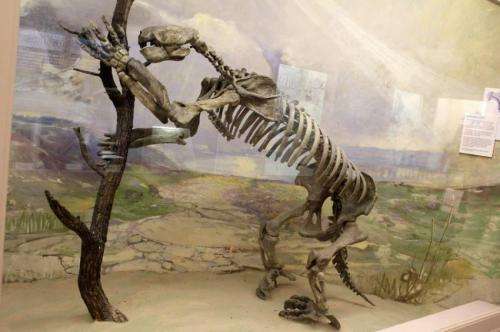Sloths are no slouches when it comes to evolution

Today's sloths might be known as slow, small animals, but their ancestors developed large body sizes at an amazing rate, according to an evolutionary reconstruction published today in the open access journal BMC Evolutionary Biology. The fast rate of change suggests that factors such as environmental conditions, or competition with other species must have strongly favored the bigger sloths, before they died out.
Scientists from UCL (University College London) and University College Dublin looked at existing models for reconstructing how sloths diversified, with some species as large as elephants, and some shrinking down to their current small sizes from a large ancestor. The study showed that some sloth lineages increased in size by over 100 kilos every million years – some of the fastest rates of body size evolution known for mammals.
Dr Anjali Goswami (UCL Earth Sciences), an author on the paper, said: "Today's sloths are really the black sheep of the sloth family. If we ignore the fossil record and limit our studies to living sloths, as previous studies have done, there's a good chance that we'll miss out on the real story and maybe underestimate the extraordinarily complex evolution that produced the species that inhabit our world."
The two existing groups of sloth species bear very little resemblance to some of their extinct relatives. The species Megatherium americanum was an elephant-sized ground sloth which could reach up to four tonnes. Fossilised track marks suggest they could walk upright on their hind legs. Eremotherium eomigrans could weigh five tons and their claws grow to a foot long. All but two sloth groups died out around 11,000 years ago, with the sloths living today reaching a maximum of 13 lbs.
The team took information about all known sloth species, both living and in the fossil record, and tested how existing evolutionary models explained the range in body sizes. They showed that models based only on living species were inadequate to explain the changes in size. Models which incorporated fossil species showed that they evolved at an extremely fast rate, and that the environmental conditions at the time must have really favored larger body sizes, such as the climate, or competition between species.
The authors say the method could be used to pry into the evolutionary past of other species.
Dr John Finarelli (University College Dublin Earth Institute), who co-authored the study, says: "There are many other groups, such as hyaenas, elephants and rhinos, that, like sloths, have only a few living species. But if we look into the distant past, these groups were much more diverse, and in many cases very different to their current forms."
More information: BMC Evolutionary Biology, www.biomedcentral.com/1471-2148/14/184
Journal information: BMC Evolutionary Biology
Provided by BioMed Central




















